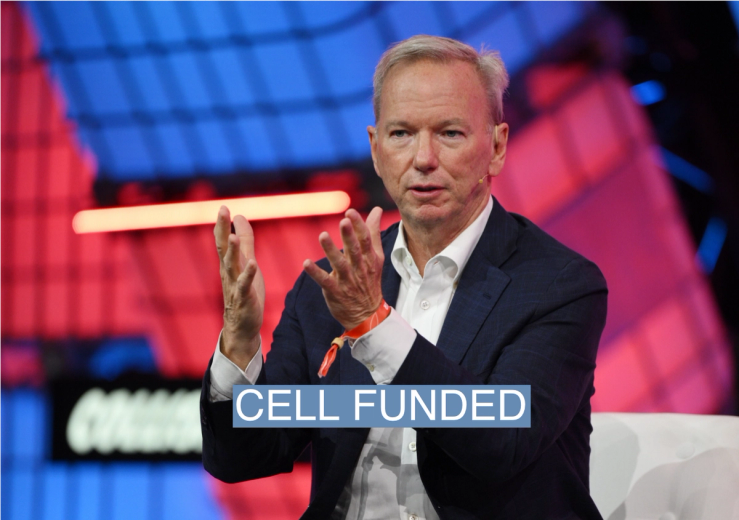The Scoop
Former Google CEO Eric Schmidt is building an ambitious new organization to tackle scientific challenges with the help of artificial intelligence, according to people briefed on the plans.
Schmidt has already hired two accomplished scientists to spearhead the nonprofit initiative: Samuel Rodriques, founder of the Applied Biotechnology Laboratory at the Francis Crick Institute; and Andrew White, a University of Rochester professor and a pioneer in the use of artificial intelligence in chemistry.
People familiar with the plans say the effort is modeled after OpenAI, the company behind ChatGPT, which was founded with great fanfare as a philanthropic organization.
Schmidt wants the new nonprofit to become a big draw for top talent in science and AI, two areas that are converging to potentially create breakthroughs in everything from drug discovery to material sciences. Funding will come mostly from Schmidt’s personal wealth, but outside funds may be necessary given the ambition of the project, people familiar with the plans said.
Schmidt intends to offer competitive salaries and resources, in particular compute power that can be difficult to come by in academia. The project is still in the early stages, the people said, and exact plans could change.
Spokespeople for Schmidt declined to comment. Rodriques and White did not respond to requests for comment.
Know More
Scientific research, particularly in the area of biotech, has become one of the hottest areas in technology, attracting talent from Silicon Valley companies working on autonomous vehicles and other fields within AI.
Breakthroughs in both computer science and in the lab have created new excitement about the application of deep learning and other forms of AI to long-standing scientific challenges. At the same time, the costs of training AI models using massive datasets have come down, making the methods more accessible to researchers.
Schmidt outlined his vision in an article last month in MIT Technology Review titled This is how AI will transform the way science gets done. “With the advent of AI, science is about to become much more exciting — and in some ways unrecognizable. The reverberations of this shift will be felt far outside the lab; they will affect us all,” he wrote.
Schmidt has also been supportive of risky bets. With his wife Wendy, he co-founded Schmidt Futures, a philanthropic organization that funds research projects that have the potential to generate a big impact, but don’t have a clear business model that would be attractive to venture capital investors.
The couple has funded several other AI-related projects, including the nonprofit AI2050 and the AI in Science Postdoctoral Fellowship Program, both focused on pushing forward the use of the technology to benefit humanity.
Rodriques and White are both relatively young and highly decorated stars in their field and have been prolific publishers. And, according to what they’ve written in articles, blog posts, and social media, they both share an intense belief that software is about to upend science.
Rodriques, who has been tasked with establishing the new organization, delivered a TED talk in 2017 where he outlined his vision of the next 100 years of brain science. His laboratory’s website describes moonshot ideas, such as curing common conditions like allergies and tackling schizophrenia, depression, and Alzheimer’s disease — all with the help of AI.
In April, Rodriques wrote that in order for AI to transform drug discovery, biologists and AI researchers need to be brought under one roof.
“AI researchers who are exposed to the nitty gritty details of how biology actually works often get scared away by the complexity, and biology researchers exposed to the details of how AI works often conclude that it cannot be trusted,” he wrote. “We will need teams of hard-core AI researchers and hard-core scientists working together, with a rapid iteration cycle, in order to build tools that leverage the cutting edge and that actually add value for the scientists.”
White, whose X handle describes him as “Tech staff at stealth AI x Bio Institute,” is the author of an online textbook titled Deep Learning for Molecules and Materials and published an article in May about large language models in chemistry. “GPT-4 can accomplish complex tasks in chemistry purely from English instructions, which may transform the future of chemistry,” he wrote.
Last year, White petitioned the Unicode Consortium to add a protein emoji, a response to the fact that searches for “protein” just turned up pictures of meat and nutrient images. “But proteins are more than that,” he wrote. “Proteins are the actual agents of life.” The emoji was ultimately rejected.
Reed’s view
Schmidt’s new venture has a lot to do with talent. The great minds in science and biology are scattered all over academia and the private sector. Schmidt wants to bring together a substantive number of them in the same place.
While the plan is to build a nonprofit, the organization could presumably develop valuable intellectual property or spin off startups, much like academic labs. In the case of OpenAI, the nonprofit essentially became a for-profit.
The move reflects a shift that is happening in Silicon Valley. For decades, the most interesting thing in the tech industry was the internet and all of the businesses built around it. And the dominant method of financing the internet was advertising.
The targeted ads and the massive wealth created were so compelling that the mainstream press and most venture capitalists have kind of forgotten about actual science and technology.
But that’s starting to change. The artificial intelligence tactics that more effectively matched ads to consumers have grown so powerful that they can now possibly be used to save lives or fight climate change. And that’s a lot more interesting.
Room for Disagreement
Since leaving Google, Schmidt has pushed to modernize the U.S. military amid a cold war with China that hinges on technological superiority. He now has an army of critics who have called out his influence over U.S. national security and defense policies.
As Schmidt becomes a bigger backer of AI and the sciences, where government funding also plays a big role, there will likely be more questions over his involvement.
The View From Europe
While Europe lags far behind the U.S. when it comes to big internet companies, it is often on the cutting edge of the sciences.
The biggest catalyst for AI and drug discovery — AlphaFold — was developed by DeepMind, a British company that was acquired by Google.
A McKinsey analysis last year found that about half of the companies in the AI-driven drug discovery industry were in the U.S., with more opening up shop in Europe.
Notable
- One of the under appreciated developments in AI in the sciences is DeepMind’s project to use AI to control heat in nuclear fusion reactions. This is just wild, but what’s crazier is that this kind of thing could be happening every day in lots of different areas of scientific research.


